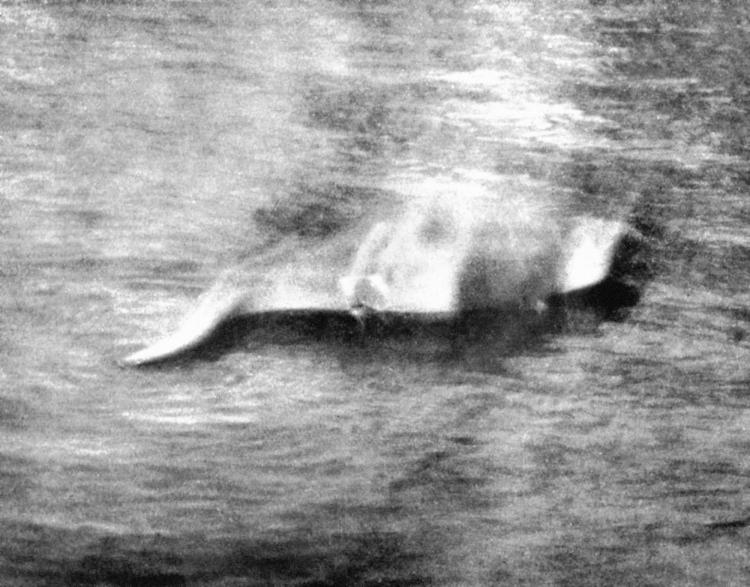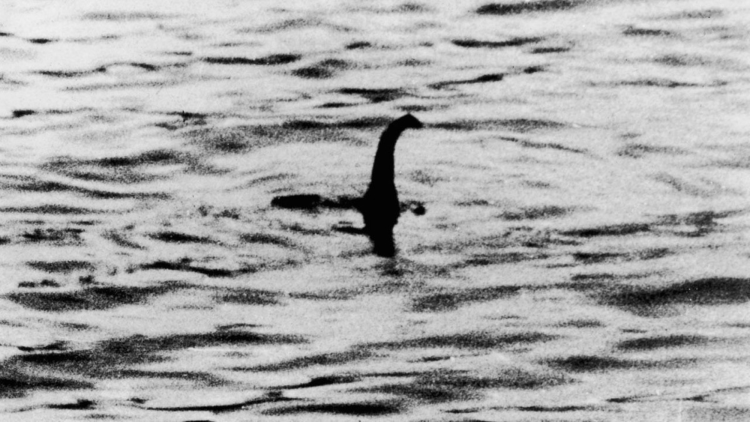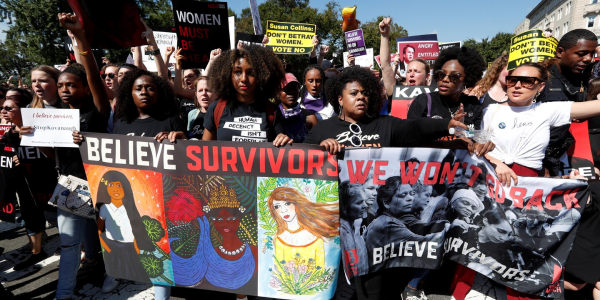Marking the 90th anniversary this month of the first 'photograph' of the Loch Ness monster, CU Boulder scholar muses on what qualifies as ‘truth’ and ‘fiction’ and the overlap of conspiracy theories and myths
Some 90 years ago this month, the publication of a photo purporting to show a creature traversing the waters in Loch Ness, Scotland, started what may be the very first viral trend.
On Nov. 12, 1933, a man named Hugh Gray took a photo of something moving in the water—although what it was, exactly, remains a deep point of contention today.
Whatever the case, that 1933 photo paved the way for many others to share their own tales of spotting the fabled Loch Ness monster—including the much more famous “surgeon’s photo” of a dinosaur-looking creature seemingly swimming in the Scottish lake, which was published in April 1934 in The Daily Mail, one of Britain’s largest newspapers.
In the 90 years since Hugh Gray’s 1933 photo was published, there have been 1,155 sightings and counting, according to Britain’s Sky News, which recently published a story on the continuing interest in the Loch Ness monster.

Hugh Gray of Scotland took what is credited as the first "photo" of the Loch Ness monster. (Photo: Scottish Daily Record)
Some would cite the many independent sightings as evidence of the creature’s existence. Skeptics, meanwhile, have attributed sightings to a host of factors, including the misidentification of mundane objects, such as driftwood, as well as the perpetration of outright hoaxes.
With each camp claiming the evidence strongly supports their side, how does the independent observer decide what is “fiction” and what is “reality”?
It’s a topic with which Annjeanette Wiese, associate chair and director of undergraduate studies of the Humanities Program at the University of Colorado Boulder, is very familiar. Wiese teaches Humanities 4170, Fiction and Reality, which concerns modern attempts to define the two categories. Additionally, she is the author of Narrative Truthiness: The Logic of Complex Truth in Hybrid (Non)Fiction, which explores the complex nature of truth by adapting TV host Stephen Colbert’s concept of “truthiness” (which on its own repudiates complexity) into something nuanced and positive. In the book, she uses narrative theory to analyze several examples of hybrid (non)fiction: works that refuse to exist as either fiction or nonfiction alone, and that challenge monolithic definitions of truth.
Recently, Wiese spoke with Colorado Arts and Sciences Magazine about how stories of the Loch Ness monster fit into larger conversations about fiction reality. Her responses have been lightly edited for style and condensed for space considerations.
Question: Regarding myths/stories like the Loch Ness monster, generally, is there any discernable element of truth to the story, or do they seem to be completely made up?
Wiese: I think these stories gain their power from the combination of the importance of perception and the power of the imagination.
Perception is not simply seeing what is in front of us. Our brain is interpreting the information it takes in on many levels, starting with the visual, but extending into realms that involve semantics, associations, emotions and sense-making.

CU Boulder researcher Annjeanette Wiese is the author of Narrative Truthiness: The Logic of Complex Truth in Hybrid (Non)Fiction, which explores the complex nature of truth.
So, when we see something that doesn’t fit into our typical understanding, we have two choices: either we normalize it so that it does fit, or we have a problem to deal with. When someone sees something unusual in the water, and there is no obvious explanation for it, the imagination kicks in. Maybe it’s a problem—maybe it’s a monster! And didn’t someone else say they saw something strange, too? When such a story spreads, it takes on more and more meaning.
At this point, it doesn’t matter anymore if the original sighting was crying wolf, because the idea of the monster has taken hold and become a sort of reality of its own, prompting further “sightings” and stories—as well as some merchandizing, I would assume.
It may be an urban legend, but how many urban legends today still make us act in what would otherwise seem to be strange ways? (Do parents still check their kids’ Halloween candy for sharp objects or poison?)
Question: With the Loch Ness monster story, there are some grainy black-and-white photos that purport to show a creature. How much 'evidence,’ if any, is required for a story/myth to take root?
Wiese: Surprisingly little evidence is required. This brings us back to ‘truthiness.’ Stephen Colbert described truthiness as what feels true rather than what is factual. Things that feel true to us can take root much more strongly than facts.
Let’s say someone knows someone who knows someone who said they saw the Loch Ness monster. That might feel truer than the likely fact that there is no such being. And then if there’s a photograph, or even the hint of one, it serves as evidence.
We probably can’t individually inspect the photograph, but we might trust that it exists if it aligns with what we think to be true. The two are mutually reinforcing, especially if we can’t inspect the evidence directly.
Another element here is that photographs make us think that what we see is real. Photographs are connected to reality—a person in a photograph, we believe, was actually there in front of the camera when it was taken. And we are often right about this. But, of course, photographs have always been manipulable, and now that the images are digital and editing technology is so advanced, all bets are (or should be) off. Yet photographs still tend to reinforce our sense that seeing is believing.
Question: Do continued advances in technology (i.e., satellite imagery, manned/unmanned exploration vehicles, prevalence of phones/recording equipment, etc.) make the creation of new myths less likely ?
Wiese: We have an increased ability to establish evidence and, arguably then, a requirement for producing it. We can hold information accountable and can do our research regarding what is already known. This might lead us to think that the creation of new myths should decrease.
For example, we see a blurry image of something in the water, but what does it actually show us? How do we know when and where it was taken? Are we going to trust the information that accompanies it, even if it isn’t personally verifiable? And now, of course, and to an increasing degree: How do we know it wasn’t tampered with?

The famous Loch Ness monster "surgeon's photo," published in 1934, was later revealed to be a hoax. (Photo: Getty)
We have to be willing to interpret what we see in a way that doesn’t simply reinforce our own assumptions, but that takes time and effort. Myths take hold and are much easier to believe than to disprove, especially if they feel true or we want them to be true.
We are also inundated with so many images and ideas, and it seems that people lack the skills or time or will to verify all of that information. So, when we interpret what we see or read or hear, other factors play a larger role than verification, such as whether it supports a narrative that we already believe to be true. We might think that if it seems true, it probably is. But, of course, this can be a dangerous presumption.
Question: Alternatively, does technology, in the form of AI, increase the chance that myths will increasingly take shape because they can create compelling photos, visuals or other evidence to advance a myth?
Wiese: AI and the vast dissemination of information that is not vetted by responsible parties mean that myths will likely keep reproducing rapidly. For a myth like the Loch Ness monster, there is a history to it that is charming and fun, but what happens when chatbots start creating myths that then are believed by those who read them despite the fact that no one has any idea where they came from?
Whether created with the aim of misinformation or mere curiosity, the end result could be the same. The creation of images and videos is probably more concerning at the moment than words, because seeing is still believing, and images impact us more immediately and viscerally than words, which take time to process. But both have power, especially when we are used to absorbing information without verifying it.
If you can simply create a story and the imagery to support it with a few phrases typed into a chat window, what’s to keep people from doing so? The question becomes what happens to that information and what does it take to make it catch on?
Question: To what extent do myths—Nessie, Sasquatch, maybe the Flat Earth movement—converge with conspiracy theories (i.e., the government or other powers are suppressing 'the truth’)?
Wiese: I worry more about conspiracy theories than myths, since the former seem to be rooted in the everyday present, at least in terms of their reach or consequences. For example, people are deciding whom to vote for based on lies. This has long been true, of course, but now it is much easier to spread misinformation.

A 1951 photo by Lachlan Stuart purported to show the Loch Ness monster; it was quickly debunked as a hoax. (Photo: The Guardian)
Here, too, truthiness plays a role. People buy into these stories because they feel like they are true, and that reinforcement of what feels true is more important to the believers than whether the stories are verifiable.
They hear a story and think, ‘Yes! That fits perfectly with what I was thinking! Of course, the government is suppressing the truth about this. If the truth got out, they’d be ruined.’ And so on.
That’s the other thing about myths and conspiracy theories alike. The evidence that would disprove them is rejected because it doesn’t reinforce the myth or theory. And as such, it feeds the narrative that the truth is being suppressed.
Moreover, people become so invested in these narratives that their very identities become tied to believing them. So, to accept contrary evidence would undermine who they think they are. And we’re all resistant to that.
Question: Do you have thoughts on why some people choose to believe in certain myths despite the lack of scientific evidence?
Wiese: We all want to believe what feels true.
This is particularly egregious in the case of conspiracy theories. When one’s worldview involves the idea that people in power are trying to keep other people from knowing the truth, then that person is predisposed to distrust the normal channels of information (e.g., the media or the government) and more susceptible to manipulation by those who would spread misinformation. And strong emotions about the issue in question reinforce this susceptibility further.
In the case of Loch Ness, it’s relatively harmless to believe there is a monster, and I would guess that there are more people who merely want there to be a monster than those who would insist on its existence. The latter, however, likely face some level of ridicule for their beliefs, which might prompt them to defend them all the more.
That’s the other thing about myths and conspiracy theories alike. The evidence that would disprove them is rejected because it doesn’t reinforce the myth or theory. And as such, it feeds the narrative that the truth is being suppressed.”
Question: What is your take on whether the line between truth and fiction is more or less clear today than it was in the past?
Wiese: I think it is less clear. Or, perhaps it is better to say that we are more aware today of how unclear it is. Some of that awareness is good: It’s difficult to talk about our experiences in purely factual ways, because that’s not how perception and interpretation work. But this is a double-edged sword, because we aren’t always attuned to those nuances, and so we treat such information as if it were fact.
And we have technology at our fingertips that enhances the degree of blurriness between fiction and reality, and all the many related terms and concepts. There is an unfortunate lack of nuance in so much of the information we process today. It’s much easier to forward or repost a video, meme or story than to think about what it really says, much less what it implies. But we can do that if we want to, and that’s why practicing critical thinking is so important.
Question: Why do certain myths (the Loch Ness monster, Area 51, etc.) seem to take hold while others fade away?
Wiese: I think curiosity and cultural narratives play a role. Loch Ness plays into the belief that there are aspects of our world that remain unknown, and to buy into that—or, more strongly, to feel like one has oneself seen something—gives the believer a sort of privileged standing. Only a special few have been lucky enough to be privy to the monster’s existence.
Area 51 works similarly, although it also ties in with stories about the government keeping secrets and not wanting regular individuals to find out. Combining UFO folklore and governmental cover-ups makes for a great story.
The possibility of a monster in Loch Ness allows us to believe in something intangible and unexplainable but ultimately harmless. Who wouldn’t want to believe it?
Did you enjoy this article? Subcribe to our newsletter. Passionate about humanities? Show your support.



